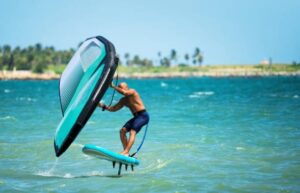Wing foiling is a dynamic and subtle sport that requires time to learn. It can be a bit intimidating watching people flying high over the water, but once you figure out how to get up and ride, it’s a blast!
Foil equipment can be expensive, but it’s possible to find deals if you shop around. Choosing the right board and wing size is important.
Getting Started
 Wing foiling can seem like a complicated, intimidating sport. It is indeed a technical sport enveloped in confusing hydrodynamic terminology and hotly debated equipment, but it can also be extremely fun and accessible to beginners, regardless of board sports experience or water expertise.
Wing foiling can seem like a complicated, intimidating sport. It is indeed a technical sport enveloped in confusing hydrodynamic terminology and hotly debated equipment, but it can also be extremely fun and accessible to beginners, regardless of board sports experience or water expertise.
Learning in the best conditions possible is important, especially as a beginner. This means a stable, flat water location with strong and consistent (not gusty) wind at 18-25 mph and a large enough area to practice going upwind and gybing. If a foiling instructor is available, it is recommended to have them guide you and accelerate your progression.
Once you feel comfortable, begin by attempting short flights and returning the board to the water. Then, progress to longer reaches and increase pressure on the back foot to build speed. Once you’ve become comfortable with these basics, it’s time to start thinking about the wing and how to maintain contact with it. The most common leash attachments are to the front/leading hand or the waist, each with pros and cons.
Boards
As wing foiling grows popular, it’s worth investing in the right equipment. There is a large selection of new gear, from beginner-level inflatables to professional-grade foils and boards.
A wing foiling board can be used in conditions other than windy, such as with a small sail and a sailboat or even on ice (though that is not recommended for beginners). The best conditions are strong, consistent winds of about 18-25 mph with flat water free of waves and chop. Learning in a location that is not busy with other marine traffic is also helpful.
When choosing a board for beginners, starting on a board larger than their weight in kilos, such as a HIPE First, HIPE Perf, or a LANCE, is recommended. As a rider progresses, it is possible to move down to smaller boards, with the foil volume equal to or less than their body weight in kilos. Expert riders can often move up to a board smaller than their body weight in kilos for maximum performance and manoeuvrability.
Wings
Wing foiling is a sport that requires wings to generate lift and propel the board across the water. These wings are attached to the rider using a harness and allow them to control their speed and direction while riding on top of the water.
As a result, this makes it easier to learn compared to other water sports. This is also why it’s becoming more popular. Unlike kite surfing, it doesn’t require specific wind conditions to be able to do so. It’s also safer than kitesurfing as there is less risk of getting caught by a gust of wind.
The best way to start with wing foiling is to find a centre offering lessons. This will give you access to the best equipment and ensure you learn reasonably. It’s also a good idea to start with an inflatable foil board as it will be lighter and more portable. Additionally, if you’re new to the sport, it can be helpful to practice behind a boat. This will help you learn how to ride the board properly and understand how the wing provides lift.
Once you’ve mastered the basics, it’s important to remember that the speed of your board will depend on how much power you put into it. You must use a larger wing if you’re trying to go fast. This will help you increase your speed and keep you safe in rough conditions.
Safety
As with all water sports, there are risks associated with wing foiling, but the risk can be minimised with proper training and equipment. The wing, board and straps can all cause injuries if they are not handled properly, so it is important to learn how to use the equipment correctly. A helmet is also recommended to protect your head from impact. Choosing one with a visor to reduce sun glare on your eyes is a good idea.
Foiling is a very versatile sport and can be enjoyed in various conditions. However, beginners should choose calm waters, preferably away from waves. This will help minimise the risk of injury and allow them to progress quickly.

